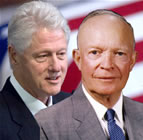 It’s a holiday concurrence: Valentine’s Day and President’s Day and American Heart Month — and former President Bill Clinton who got his heart fixed six years ago and just got a “tune-up”, is already back home. He was having discomfort, so yesterday morning he saw his cardiologist, he was wheeled into the cath lab — an hour later he had two stents opening up one of his original coronary arteries (not one of the bypass grafts which had closed completely) and this morning, less than 24 hours later, he was at home in Chappaqua and no doubt already on the phone and back to work. His prognosis: excellent — this incident should not affect or hinder him in any way.
It’s a holiday concurrence: Valentine’s Day and President’s Day and American Heart Month — and former President Bill Clinton who got his heart fixed six years ago and just got a “tune-up”, is already back home. He was having discomfort, so yesterday morning he saw his cardiologist, he was wheeled into the cath lab — an hour later he had two stents opening up one of his original coronary arteries (not one of the bypass grafts which had closed completely) and this morning, less than 24 hours later, he was at home in Chappaqua and no doubt already on the phone and back to work. His prognosis: excellent — this incident should not affect or hinder him in any way.
Whatever your take on comparative effectiveness research, whether too many stents are used, etc., you have to admit it’s pretty amazing. The advances made in diagnosis, bypass surgery and interventional catheter-based techniques have revolutionized the treatment of coronary artery disease. Especially when you look back at how this illness used to be treated (or not).
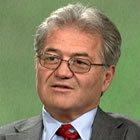
Dr. William O’Neill
Dr. William W. O’Neill, Professor & Executive Dean for Clinical Affairs, University of Miami, Division of Cardiology has a favorite lecture that he gives on this topic. He goes back to 1955 and describes how then President Eisenhower’s chest pains were first diagnosed as gastric upset and finally almost a day later an EKG showed he was in the midst of a massive heart attack. But there was nothing any doctor could do then, except give Ike morphine for the pain. The heart attack had to play itself out, Ike’s heart muscle was damaged and he was in the hospital for 7 weeks. He didn’t return to work for 3 months. (for you young folk, our Vice President at the time was Richard Nixon!). Ike did continue as President and, in fact, was re-elected to a second term (after all, he was THE hero of WWII). But without question, his ability to lead a fully active life was significantly compromised and ultimately, in 1967, he succumbed to heart disease.
The take-away from Bill Clinton’s episode is that even though his quadruple bypass surgery was successful, the natural history of coronary artery disease is that it will progress. Surgery, angioplasty, stents, medicine — none of these are cures, but they are interventions in this progression. Along with the medications, exercise, diet and smoking cessation, the natural history can be slowed down. Clinton, having experienced this pain previously, knew it was significant and did precisely the right thing: he saw his cardiologist.
* * * * * *
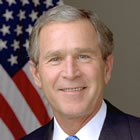 Updated February 15, 2015: The above post from 2010 was written, of course, just after Bill Clinton received his stents. Since then, George W. Bush has also benefited from this technology, as well as Supreme Court Justices Kennedy and Ginsberg, Dick Cheney, and no doubt quite a few Senators and Representatives.
Updated February 15, 2015: The above post from 2010 was written, of course, just after Bill Clinton received his stents. Since then, George W. Bush has also benefited from this technology, as well as Supreme Court Justices Kennedy and Ginsberg, Dick Cheney, and no doubt quite a few Senators and Representatives.
Updated June 12, 2018: Since this post, Dr. O’Neill has moved from Miami and is now the Director of the Center for Structural Heart Disease at Henry Ford Hospital in Detroit. He can be found on Twitter as @BillONeillMD.
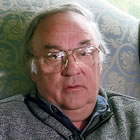

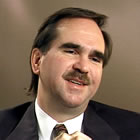
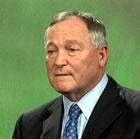

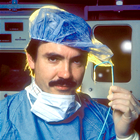 34 years ago, Andreas Gruentzig performed the first coronary angioplasty. Rather than cutting open the chest, sawing through the sternum and sewing a bypass conduit (harvested from the leg or internal mammary artery) into the coronary artery, he elegantly threaded a balloon catheter to the blockage through a small incision in the femoral (groin) artery, in an awake patient. He then inflated the balloon, compressing the plaque against the arterial wall and opening the artery. The procedure was a total success and his first patient, Adolph Bachmann, is alive and well today! (
34 years ago, Andreas Gruentzig performed the first coronary angioplasty. Rather than cutting open the chest, sawing through the sternum and sewing a bypass conduit (harvested from the leg or internal mammary artery) into the coronary artery, he elegantly threaded a balloon catheter to the blockage through a small incision in the femoral (groin) artery, in an awake patient. He then inflated the balloon, compressing the plaque against the arterial wall and opening the artery. The procedure was a total success and his first patient, Adolph Bachmann, is alive and well today! ( It’s a holiday concurrence: Valentine’s Day and President’s Day and American Heart Month — and former President Bill Clinton who got his heart fixed six years ago and just
It’s a holiday concurrence: Valentine’s Day and President’s Day and American Heart Month — and former President Bill Clinton who got his heart fixed six years ago and just 
 Updated February 15, 2015: The above post from 2010 was written, of course, just after Bill Clinton received his stents. Since then,
Updated February 15, 2015: The above post from 2010 was written, of course, just after Bill Clinton received his stents. Since then, 

